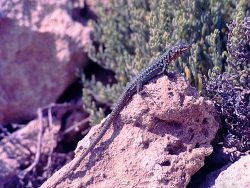News of the collapse of the Azure Window have made it to the international media and one cannot deny that Gozo has lost one of its natural wonders, created by nature and reclaimed by nature itself. That’s how nature is after all – it gives and it takes, and most of us have been lucky to witness this colossal natural structure inspire many tourists and locals.
Its disappearance on Wednesday morning has brought sadness to many, akin to a sadness of losing another human being – something irreplaceable, unique and impossible to bring back which now lives in photographic memory.

The Scopoli’s Shearwaters come in to feed their chicks during summer at Dwejra (Photo by Paulo Lago)
The public outcry over this loss has been remarkable. Many environmentalists like myself, however wonder whether we would have had such an outcry, had we lost an endemic plant or a lizard from the Maltese Islands, as a result of our own doings, rather than a natural phenomenon. My gut feeling is that this would probably not be the case as a result of a lack of awareness or appreciation, or even simply by missing out it ever existed all together. Few probably know, that we have for example in recent years lost the endemic Selmunett wall lizard, a lizard confined to St Paul’s Islands for millennia before even the name was coined for the place. It evolved to become a unique subspecies, and its extinction as a result of our own wrong-doings, and not some stormy weather, went in silence.

The Fungus Rock Wall Lizard. Found nowhere else on earth, this lizard lives on the strictly protected nature reserve of Fungus Rock at Dwejra. Photo by Joe Sultana during the photographer’s visit to the island in 2003
Our islands are a unique place, lifted from the seafloor and isolated over time from Europe and Africa. Dwejra without its majestic Azure window is still a colossal monument on its own. Its rock formations witness the passage of time, from the thousands of ocean dwelling organisms immortalised as fossils, to its unique array of caves, inland sea and a rock islet which stands isolated harbouring until this very day unique life forms. Fungus rock has its very own lizard subspecies confined to nothing more than an area less than 7,000 square metres and found nowhere else on Earth. The Knights of St John at the time did not even recognise it, yet they did their best in protecting the islet for what they thought was a ‘fungus’ that cured sexual problems grew only there. A case of mistaken identity as the fungus turns out to be a parasitic plant and is not just confined to the rock.
However little did the knights know that their actions in protecting the rock have probably ensured us the survival of the Fungus Rock Wall Lizard, a species that has taken far longer to evolve than the time taken for the formation and disappearance of the Azure Window. It truly puts into perspective how valuable our actions are in preserving something unique over time, for the next generation. Many of us are simply angry for having lost the Azure window without the possibility of intervening and keeping it for posterity. We simply could not do anything and we have to accept that.

Cynomorium coccineum – the flowering body of this parasitic plant, mistaken for a fungus is what guaranteed protection to Fungus Rock for hundreds of years. Photo by Joe Sultana
How important is it then that we truly keep and preserve our natural heritage from our own damaging actions. Dwejra is a protected site in all its imaginable forms. The land area is designated as a Natura 2000 site for its fauna, flora and habitats. It comprises a bird sanctuary, an area of ecological importance, a site of scientific importance and a tree protection area. The seas around Dwejra are also protected – one of our very first Natura 2000 sites at sea was designated here to protect its marine habitats. Yet beyond these titles, the place is far from being preserved in its pristine conditions.
We’ve all read at what’s at stake – last year someone tried using explosives at the inland sea inlet to make way for more boat traffic. Illegal boathouses have for years mushroomed in the area, some being removed while others getting sanctioned. Illegal off-roading by jeeps and motorbikes lay waste of waterways while bird trapping sites within metres of the azure window spread herbicide to clear vegetation along the cliffs. Divers keep encountering nets from illegal fishing, while events, parties and film sets have been organised insensitively causing irreparable damage to the fossilised rock strata. How long will this place sustain the pressure before we need another azure outcry?
Our natural heritage is not just a rock formation that stands for a few hundreds years before it gets eroded away. It came into being over a longer time span. Yet it only takes a little to lose it forever. We do not need any international initiatives to make the place great – it still is. All we need is to pull up our own sleeves and protect what we are lucky to still have. Just head down to the slipway next to Fungus Rock on a summer night, quietly and without using any lights, and see to yourself how the place livens up at night with the calls of our Scopoli’s Shearwaters coming in to feed their chicks. Just a lit up fancy kiosk at night or a boat party there can make them all go away for ever. You can make a whole difference – respect the site, report illegalities to authorities, speak to your politicians or support an environmental NGO.
By Nicholas Barbara, BirdLife Malta Conservation Manager
This blog was originally published by the Sunday Times of Malta.
